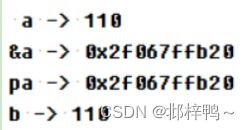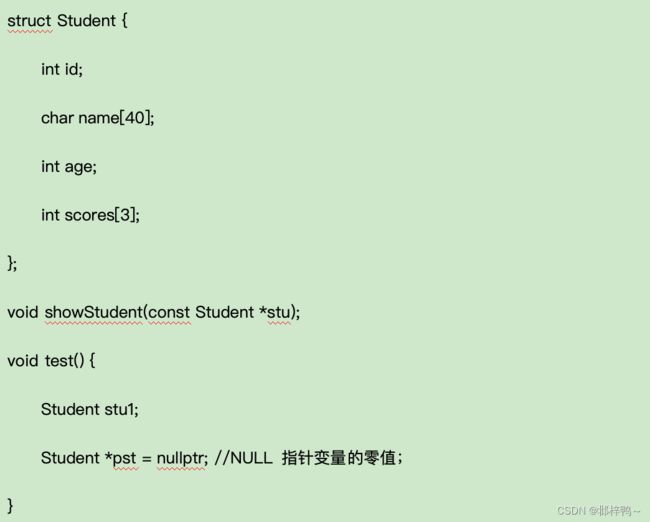QT软件实习笔记1
2024.1.13
上午
1.课堂练习一
键盘上输入一个人的年龄,并且输出;用自己习惯的开发环境
#include
int main() {
int age;
std::cout << "请输入您的年龄:";
std::cin >> age;
std::cout << "您的年龄是:" << age << std::endl;
return 0;
} 问题:
开发环境(win):
1. vs 2019(比最新版本第一个版本);
2.Dve C++ 5.11;
3.clion
需要注意的点:
1. 目录或文件命名时,不要使用中文:使用中文可能没有问题,使用英文一定没有问题:
2. #include 和具体头文件用空格间隔;#include
3. 变量命名时,不要使用a,b,c等,更不要使用拼音:见名知意:做上线项目时,遇到
某些变量名,不知英文,查一下英文表示;
4. 一个变量没有有效值时(如需从键盘输入):此时需要给这个变量赋值,用相应类型的
〝零值”赋给它;
- 整数类;int最常用,效率也最高
- 实数类;
- 字符类;
5. 测试边界问题:就是输入数据的范围:有几种可能性,就要有几种测试:
6. 当声明多个变量时,无论这些变量是否属于同种类型,是简单变量还是指针变量,还是数组,一个变量占一行:如果变量没有有效值,都要赋相应类型的零值;(对应第三题的时候,注意不同版本语言的语法变更)
如是数组,将数组中的每个元素赋以相应类型的零值;
参考代码:
void test ();
int main() {
printf("\n");
test();
printf("\n");
return 0;
}
void test() {
int age = 0;
cout << "input age : ";
cin >> age;
printf("\n");
//输入数据的有效性检查
if (age < 1){
cout << "年龄小于等于0,无效!" << endl;
//return;
} else if (age > 120) {
cout << “年龄大于120,无效!" << endl;
} else {
cout << "age = m << age << endl;
}
}2.课堂练习二
有一个数组,用来存放1-9之间的数字,计9个元素,int numbers[9]={4,1,3,2,6,5,8,9,};从1~9中,将数组中的7找出来;
#include
using namespace std;
int main() {
int numbers[9] = {4, 1, 3, 2, 6, 5, 8, 9};
int target = 7;
bool found = false;
for (int i = 0; i < 9; i++) {
if (numbers[i] == target) {
found = true;
break;
}
}
if (found) {
cout << "数字7在数组中找到了!" << endl;
} else {
cout << "数字7在数组中未找到。" << endl;
}
return 0;
} 1.第一种方式(参考代码):
#include
using namespace std;
void test();
int main() {
printf("\n");
test();
printf("\n");
return 0;
}
void test() {
int sum1 = 0;
int sum2 = 0;
int numbers[9] = {4, 1, 3, 2, 6, 5, 8, 9,};
//在循环这类操作中,计数器可使用简单变量名:i,j,k等;
for (int i = 1; i < 10; ++i) {
sum1 += i;
}
for (int i = 0; i < 9; ++i) {
sum2 += numbers[i];
}
int result = sum1 - sum2;
cout << "result -> " << (result) << endl;
} 2.第二种方式(参考代码):(在C语言或C++的运算符中,有二进制运算符;)
- 二进制的“左移”和“右移”;
- 二进制“非”
- 二进制“异或”
- 二进制“或”
- 二进制“与”
#define Max 9
void test() {
int numbers[Max] = {4, 1, 3, 2, 6, 5, 8, 9,};
int result = 0;
for (int i = 1; i < 10; ++i) {
result ^= i;
}
for (int i = 0; i < Max; ++i) {
result ^= numbers[i];
}
cout << "result -> " << (result) << endl;
}3.课堂练习三
有一个正整数12345,求它的二进制表示;后面扩展为16进制;
经查询资料,我们可以使用bitset库来进行二进制转换。bitset<32>(num)将整数num转换为一个32位的二进制数,然后使用to_string()方法将其转换为字符串表示。
#include
#include
using namespace std;
int main() {
int num = 12345;
string binary = bitset<32>(num).to_string();
cout << binary << endl;
return 0;
} 或者定义一个函数decimalToBinary,将十进制数转换为二进制字符串。
#include
#include
std::string decimalToBinary(int decimal_num) {
std::string binary_str = "";
while (decimal_num > 0) {
int remainder = decimal_num % 2;
binary_str = std::to_string(remainder) + binary_str;
decimal_num /= 2;
}
return binary_str;
}
int main() {
int decimal_num = 12345;
std::string binary_str = decimalToBinary(decimal_num);
std::cout << "Binary: " << binary_str << std::endl;
return 0;
} - 转换的概念:对于将10进制到N进制的转换(值大小不变,只是换种方式表示);
- 转换方式:除以N,取余,反写;
- 具体;
- 数组方式;
- 自定义数据结构方式;
- 预定义的STL模板方式;stack
- push,进栈、入栈、压栈;
- top,显示头元素;
- pop,出栈,弹栈;
- empty,判断栈是否为空;
- 思路:将余数入栈,值缩小2倍;循环直到值为0;当栈非空,不断弹栈,得到结果;
参考代码:
void test() {
int number = 12345;
cout<<" number -> "<<(number)< bin;
while (number) {
int mod = number % 2;
bin.push(mod);
number /= 2;
}
while (!bin.empty()) {
cout< 4.课堂练习四
将练习3中的2进制改为16的转换;a,b,c,d,e,f | A,B,C,D,E,F;
在C语言或C++中,关于布尔类型之“真假”问题。
- 在C语言中,对于真假,遵循一个原则进行条件判断:“非零为真”;
- 到了C++中,有了布尔类型;bool => false | true; 但因为C++兼容C语言,所以仍然支持非零为真;
参考代码:
注意整数到字母的转换
在C++中,
#include
#include
#include
using namespace std;
void test();
int main() {
printf("\n");
test();
printf("\n");
return 0;
}
void test() {
int x = 12345;
cout<<"x= "< bin;
while(x){
int mod = x % 16; // 0~15 '0' 整数0与字符0之间存在 '0'=0+48
if(mod<10){
bin.push(mod+48);
}else{//10-15 'a'
bin.push(mod+'a'-10); // 11: 1+'a'
}
x/=16;
}
while(!bin.empty()){
printf("%-2c",bin.top());
bin.pop();
}
} 下午:
5.有用的关键字auto
- 最早起源于C 语言,存在感非常低,实际上处于省路狀态;到了C++的11 版本之后,对回
此关键字进行了改造,让其具有“类型推断"的功能; - 如何类型推断?对某个变量的数据类型进行推断,推断这个变量是什么类型?这个变量是
慰了初值的;
void test() {
auto a = 12;
cout << "typeid(a) -> " << typeid(a).name() << endl;
auto b = 12L;
cout << "typeid(b) -> " << typeid(b).name() << endl;
auto c = 12LL;
cout << "typeid(c) -> " << typeid(c).name() << endl;
}(对复杂布局进行推断)
6.指针
- 指针是指针变量的简称,从某个角度上说,指针变量与整型变量没有区别:大家都是变量,都有值,值都会放在内存中;
- 既然是变量,它就要保存数据:与整型变量 age 所表示的整数值不同;指针变量保存的是
地址值; - 地址值是什么,(地址是字节的编号a,&a)变量的内存地址
- 电脑内存
win——我的电脑 -》右键-〉属性:
mac——设置-》通用-〉关于
1 kb = 1024 byte
1 mb = 1024 kb
1 gb = 1024 mb
1 tb = 1024 gb
16*1024*1024*1024 bytes
void test() {
int a = 110;
cout << " a -> " << (a) << endl;
cout << "&a -> " << (&a) << endl;
//存放地址值的变量,就是指针变量;
int *pa = &a; //&取地址运算符;从变量到地址
cout << "pa -> " << (pa) << endl;
int b = *pa; //* 解引用运算符;从地址到变量;
cout << "b -> " << (b) << endl;
}7.指针的三个用途:
指向,就是指针变量,保存了什么变量的地址;就说这个指针变量指向了谁。
- 指向单个变量;就是保存了变量的地址;
- 复杂变量(类或结构对象);
- 简单变量;内置类型;
- 指向数组;就是指针保存了数组的地址;
- 指向函数;就是指针保存了函数的地址;函数指针;
在C++中的结构与类几乎没有区別,只在访问级别有所不同;
(在结构中,没有访问级别,标明为公有;在类时为私有)
在C++中,结构体和类是两种用于定义自定义数据类型的关键字。它们之间的主要区别如下:
-
1. 成员默认访问权限:在结构体中,默认的成员访问权限是公共的(public),而在类中,默认的成员访问权限是私有的(private)。
-
2. 成员函数:在结构体中,可以定义成员函数,但是默认情况下,结构体的成员函数是公共的(public)。而在类中,成员函数默认是私有的(private)。
-
3. 继承:结构体可以继承自其他结构体或类,也可以作为基类被其他结构体或类继承。而类可以继承自其他类,也可以作为基类被其他类继承。
-
4. 默认构造函数:在结构体中,如果没有显式定义构造函数,编译器会自动生成一个默认构造函数。而在类中,如果没有显式定义构造函数,编译器也会自动生成一个默认构造函数。
-
5. 默认析构函数:在结构体中,如果没有显式定义析构函数,编译器会自动生成一个默认析构函数。而在类中,如果没有显式定义析构函数,编译器也会自动生成一个默认析构函数。
-
6. 类型转换:结构体和类都可以进行类型转换,但是在类中,可以通过重载类型转换运算符来自定义类型转换的行为。
-
7. 使用习惯:一般来说,结构体用于表示一组相关的数据,而类用于表示一个对象的属性和行为。
-
课堂练习5
利用上述的半成品代码,进行以下的练习;
1. 将声明的显示学生对象的函数 showStudent 实现;
2. 将对象stu1进行赋值并输出;
3. 通过指针变量pst向堆区申请内存,并给分量赋值后输出;
参考代码:
struct Student {
int id;
char name[41];
int age;
int scores[3];
};
void showStudent(const Student *stu);
Student input();
void test() {
Student student = input();
printf("\n");
showStudent(&student);
}
void showStudent(const Student *stu) {
//if (stu == nullptr) {
if (!stu) {
return;
}
printf("Student{%d,\"%s\",%d,[%d,%d,%d]}\n", stu->id,
stu->name, stu->age, stu->scores[0], stu->scores[1],
stu->scores[2]);
}
Student input() {
Student std;
cout << "input id: ";
cin >> std.id;
//getchar();
cin.get(); //接受键盘缓冲区中遗留的字符,这里为换行符
cout << "input name: ";
cin.getline(std.name, sizeof(std.name));
cout << "input age: ";
cin >> std.age;
cout << "input three scores: ";
cin >> std.scores[0] >> std.scores[1] >> std.scores[2];
return std;
}(getchar()=C++中的cin.get()接受键盘缓冲区中遗留的字符,这里为换行符)
4. 结构指针变量,使用堆区(heap)内存;堆区内存使用考虑以下四点;(Stack栈提供指令)
- 申请;new | malloc
- 检测;
- 使用;
- 释放;delete | free
void test() {
Student *pst = nullptr;
//1.申请;向银行贷款
pst = new Student;
//2、检测;贷款是否成功
if (!pst) {
cout << "内存申请失败" << endl;
return;
}
//3、应用;可以用贷款干事;
*pst = input();
printf("\n");
showStudent(pst);
//4、释放;向银行返还贷款
delete pst;
pst = nullptr;
}9. C++中的运算符重载
C++中运算符的重载有何优点?操作类或结构对象时 (直观);
在C++运算符重载功能,我们必须要掌握的两类运算符;
- 比较运算符;与排序有关;
- 输入(>>)、输出(<<)运算符;与输入、输出有关;
- 为何整数可以直接输出,而自定义的结构或类对象不可以? 因为int,double等类型是语言内置的,它可以用于代码的任何角落,cout或cin这些运算符支持(认识内置类型);而自定义类型,编译器或运算符不认识,也不会支持;所以是不能输入或输出自定义类型对象的;
- 因为直接输入和输出是比较直观的,我们想像输出内置类型变量一样,输出自定义对象;就要让编译器或cout/cin认识我们自定义的对象;如何认识?在类或结构中,需要重载输入和输出运算符;
- 理论上说,默认一个结构或类,都(每一个!)要有自己的输入、输出运算符重载;
struct Value {
int value;
friend ostream &operator<<(ostream &out, const Value &obj) {
return out << "Value{" << obj.value <<"}";
}
friend istream &operator>>(istream &in, Value &obj) {
return in >> obj.value;
}
};-
#include#include #include #include using namespace std; void test(); int main() { printf("\n"); test(); printf("\n"); return 0; } struct Student { int id; char name[41]; int age; int scores[3]; }; struct Value { int value; friend ostream &operator<<(ostream &out, const Value &obj) { out << "Value{" << obj.value << "}"; return out; } friend istream &operator>>(istream &in, Value &obj) { in >> obj.value; return in; } }; void test() { Value v1{10}; cout << v1 << endl; printf("\n"); cout << "input v1: "; cin >> v1; cout << v1 << endl; } 作业
-
针对结构Student,完成学生对象的输入和输出;重载后,可以执行如下的操作;
// main.cpp
// QT1.13
#include
using namespace std;
struct Student
{
int id;
char name[41];
int age;
int scores[3];
friend ostream &operator<<(ostream &out,Student &s)
{
out<<"Student ID:"<>(istream &in,Student &s)
{
in>>s.id;
in>>s.name;
in>>s.age;
for(int i = 0;i < 3;i++)
in>>s.scores[i];
return in;
}
};
void Student_Operator()
{
Student s;
cout<<"请输入对应学生学号:";
cin>>s.id;
cin.get();
cout<<"请输入对应学生姓名:";
cin.getline(s.name,sizeof(s.name));
cout<<"请输入对应学生年龄:";
cin>>s.age;
cout<<"请依次输入对应学生三科成绩:";
cin >> s.scores[0] >> s.scores[1] >> s.scores[2];
cout<<"学生信息如下:"< 2. 针对示例的Value类,进行 + 和 – 这两个运算符进行重载,能够直观的表示两个Value对象的如下操作;
//
// main.cpp
// QT1.13
//
// Created by sofia on 2024/1/14.
#include
using namespace std;
struct Value
{
int value;
Value operator+(Value &v)
{
Value temp;
temp.value = this->value + v.value;
return temp;
}
Value operator-(Value &v)
{
Value temp;
temp.value = this->value - v.value;
return temp;
}
Value operator*(Value &v)
{
Value temp;
temp.value = this->value * v.value;
return temp;
}
Value operator/(Value &v)
{
Value temp;
temp.value = this->value / v.value;
return temp;
}
bool operator>(Value &v)
{
return this->value > v.value;
}
bool operator<(Value &v)
{
return this->value < v.value;
}
friend ostream &operator<<(ostream &out,Value &v)
{
out << v.value << endl;
return out;
}
friend istream &operator>>(istream &in,Value &v)
{
in >> v.value;
return in;
}
friend ostream &operator<<(ostream &out, bool b)
{
out << (b ? "true" : "false") << endl;
return out;
}
};
int main()
{
Value v1, v2;
cout << "请依次输入Value值:";
cin >> v1 >> v2;
Value sum = v1 + v2;
Value difference = v1 - v2;
Value product = v1 * v2;
Value quotient = v1 / v2;
bool greater = v1 > v2;
bool less = v1 < v2;
cout << "Sum: " << sum << endl;
cout << "Difference: " << difference << endl;
cout << "Product: " << product << endl;
cout << "Quotient: " << quotient << endl;
cout << "Greater: " << greater << endl;
cout << "Less: " << less << endl;
return 0;
}
这里的0,1表示false,ture









